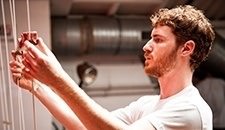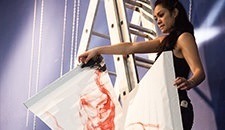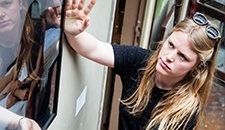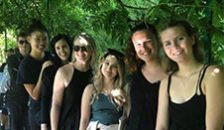
MATHEW HOCKLEY SMITH runs an independent and discreet art advisory service for private clients and organisations seeking professional guidance, or who wish to buy or sell contemporary art.
He talks about his job, how to become an art consultant and his views on the role of consultants in the art market in the context of the new IESA MBA in Art Collecting Management.
Lets begin with some account of how you yourself became a consultant as your career shows the varied background needed to work in this profession.
I was very fortunate in my background as I have worked for all the major auction houses before ending up as director of Hockley Smith. Technically I am a generalist; a specialist in a variety of contemporary paintings. I started a porter at 18 and learned on the job. The good thing about auctions is that there is always a great deal of movement, you see so much stuff and if you take advantage of the job, you can learn so much. You don’t have time to go into depth but you learn a lot. I then went into general valuations and added specialised expertise in a variety of fields, including wine for example. I then became director of business development at Christies, dealing with high-level clients, family trusts etc. I also worked at Philips Auction house as a regional director, which meant that I added management and business skills to my portfolio but importantly within an art context.
Unexpectedly I was approached through a recruitment firm to take on the role at the Lisson Gallery, London of sales director and to help them in the restructuring of the gallery. Although I had had no intention of leaving the auction world, I realised that this could offer me something new and exciting. At this stage, although I was working in the contemporary market, I had done very little work with artists and I realised that this gave me an opportunity to redevelop myself and change my focus as it brought me into contact with the primary market and the artists, which is really what led me to what I do today.
How would you describe your consultancy?
We have a very broad consultancy, which works the entire art world circle: artists, galleries, museums, secondary auction houses, public sector and private sector, collectors, artists, art as an asset class, which means writing art functions for private banks reports for companies. We also offer expertise to banks and investment, writing reports. Having a good understanding of the market as a whole means that we can bring that specific expertise to all these areas, as we know how they interact and work with each other. One of the things I most enjoyed at LIsson Gallery was working with the artists; on the other hand I felt restricted by the small number of artists you get to know. You drill down deeply but the facility to learn beyond the gallery programme is harder.
So it really was the freedom to choose the way you worked – or maybe it was the freedom to choose the artists you could work with that led to your decision to make this change in your career?
Well really it is the freedom to choose the people I work with, whether artist, academics and others. And yes, it is working with the artists that I hugely enjoy, being with such incredibly interesting people. I found I enjoyed working with them and seeing how to help them in their careers.
I had no real intention of leaving Lisson but there came a point when it made sense. I remember very well the moment, walking on the Downs, when I said to myself, I can do this. I know enough- not everything but enough. So at the worst moment for the market, in 2008, possibly the worst time on the planet, I decided to set up my own consultancy.
How do you find your artists?
I don’t find them, they find me. We don’t advertise so it is really word of mouth but I have over 30 artists, some household names, some emerging. Actually there is one artist I approached just recently. I saw her work in a show and liked it very much, so I contacted her and now will do a studio visit. I don’t know what will come of it, but it will be interesting to see her and to see her work.
Will you do more of this?
I have to. Increasingly as galleries are unable to continue to work in the traditional way and develop their artists, the artists need more and more support and help in directing their careers. I have to find ways to work with more artists to give them the support that galleries aren’t giving and to give them proper value to give them credible roots and commercialise their works.
How does working with the artist compare with working for your clients?
Its very different. Most of our clients are ultra-high net worth individuals, so it is very different. We develop academic programmes to help them learn. It is not aesthetic values or even working on acquisition policy but to show them how they can form their collections. It is more technical, about how the art market works, the differing ways you can engage, whether to go to galleries or to the auctions houses; what the differences are between the primary and secondary markets, to help them understand the people they are talking to so that by the end of a year, they are in a position to make decisions about their collections.
Moving on and thinking about how to prepare people to work as art consultants or art advisors, even wealth managers, how do you see the differences between these groups of people? Are they very different?
No I think increasingly they are very linked and maybe it will be necessary to redefine the terms. Whenever you are involved with artists you are involved with collectors, and if you know about what galleries want, you are able to help the artists. The reason why art consultancy works is because you are able to bring expertise to all those different areas.
What about wealth and investment advisors?
They are very different to art advisors. However, increasingly high net worth individuals want to deal directly with the art advisor because art is often very personal, so investing in art is very different to the collector from other types of investment.
Art funds are very different again, but they too have had to diversity and now they offer a range of consultancy advice to their clients. However, they also need do knowledge of art as they need to know the value of what they are backing. Recently I was shown a picture of a Picasso, that the investment fund was prepared to lend – lets say two million dollars. When I asked them how they came to that valuation, they said it came from the data. But it was not such a good work by the artist and the data does not understand this. It would not have fetched more than £250,000 on the market. So it would have been crazy to lend a million on it and if there had been a default on the loan, they would have lost a lot of money.
How does someone prepare to work in this field? What is the growth progress?
The concern that I see with people targeting consultancy as a career is that you need either tame collectors who will sponsor you through your learning or you have to have a specific experience or expertise. In the art world, the client wants to talk to the person they know has the expertise and although
What would you look for in someone you might employ?
A level of expertise in one sector, or at least having started targeting one area of expertise. Beyond that what I want to see is people who are sensitive to the structures of the art world so that they understand the differences between primary and secondary markets, they understand the dynamics between gallery and artists and the collector and gallery. However, to be honest mostly I value the ability to learn. Always the real requirement is determination and the desire to be in this world.
Particularly in the contemporary art market, what is really needed is flexibility because the contemporary art market is like no other. It’s really a futures market, so what gives contemporary art its value, is the academic credibility that underwrites the work. Academia and the credibility that goes with academia underpins the artist. However, the art market is massive and can range between the more commercial and the more academic. So you need to know where you position yourself in this world.
Whereas in the Old Master field, you can concentrate on more traditional approaches, but you still need to know how to find new artists, how to find new works. So what kind of training might you look for if you were going to take on an employee?
In this world, the clients do really want to work with someone who they trust has the experience to advise with them, plus of course, there is a personal relationship with any client. However, I can see that having a knowledge of handling, insurance, restoration and conservation, art law, shipping, these are all technical areas where someone could start working for a consultant and learn the expertise and business skills they need. There are a lot of add-on bits you can bring to
That could be an area that could grow without your involvement
Yes, indeed that could be. What is important is that the student has an area of interest and expertise that they make their own. It provides a discipline that is a useful way to judge their future development and commitment


 Download application form
Download application form 


